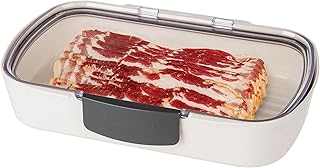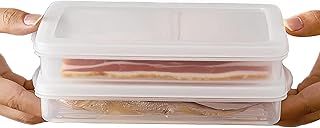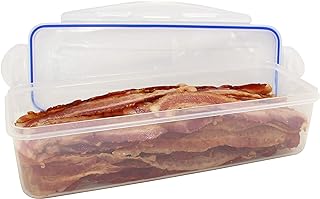|
When it comes to food safety, understanding whether cooked ham needs to be refrigerated is essential for preventing spoilage and potential foodborne illnesses. Cooked ham, whether store-bought or homemade, is a perishable product that can harbor bacteria like *Listeria* and *Salmonella* if not stored properly. While some types of ham, such as dry-cured or canned varieties, may have a longer shelf life at room temperature, most cooked hams require refrigeration to maintain freshness and safety. The USDA recommends storing cooked ham in the refrigerator at or below 40°F (4°C) and consuming it within 3 to 5 days, or freezing it for longer storage. Proper handling and storage are crucial to ensure the ham remains safe to eat and retains its quality. Characteristics ValuesRefrigeration Requirement Yes, cooked ham must be refrigerated to ensure safety and maintain quality. Shelf Life (Refrigerated) 3-5 days Shelf Life (Unopened, Refrigerated) 1-2 weeks (check "use-by" date) Shelf Life (Opened, Refrigerated) 3-5 days Freezer Storage Yes, can be frozen for 1-2 months Food Safety Risk High risk of bacterial growth (e.g., Listeria, Salmonella) if left unrefrigerated Temperature Danger Zone 40°F - 140°F (4°C - 60°C); avoid leaving ham in this range for >2 hours Packaging Store in original packaging or airtight container to prevent contamination Reheating Reheat to 165°F (74°C) before consuming if stored for extended periods Signs of Spoilage Off odor, slimy texture, discoloration, or mold growth USDA Recommendation Always refrigerate cooked ham promptly after purchase or cooking Explore related products
$11.72 $16.99
$22.39 $27.99
$12.74 $17.53
$10.99
$14.99 $15.99
$13.99 What You'll Learn
Cooked ham, a staple in many households, is highly perishable due to its moisture content and protein-rich composition, which bacteria thrive on. The USDA’s Food Safety and Inspection Service (FSIS) emphasizes a critical rule: refrigerate cooked ham within 2 hours of preparation or purchase to inhibit bacterial growth. This "2-hour rule" becomes 1 hour if the ambient temperature exceeds 90°F (32°C), as warmer conditions accelerate microbial activity. Failure to adhere to this guideline can lead to the proliferation of pathogens like *Salmonella* and *Listeria*, which are common culprits in foodborne illnesses. The science behind this recommendation lies in the "danger zone"—the temperature range between 40°F (4°C) and 140°F (60°C)—where bacteria multiply rapidly. Cooked ham left unrefrigerated within this window becomes a breeding ground for harmful microorganisms. For instance, *Listeria monocytogenes* can grow at refrigeration temperatures but is significantly slowed below 40°F. By chilling ham promptly, you not only halt bacterial growth but also preserve texture and flavor, ensuring the meat remains safe for consumption for 3–5 days. Practical implementation of this guideline requires vigilance, especially during gatherings or holidays when ham is often served at room temperature. Use shallow containers to expedite cooling and divide large portions into smaller batches to hasten refrigeration. If ham is part of a buffet, place it on ice or use chafing dishes to maintain safe temperatures. For leftovers, wrap tightly in plastic wrap or aluminum foil, or store in airtight containers to minimize exposure to air and moisture, which can accelerate spoilage. Comparatively, other cooked meats like turkey or roast beef follow similar storage protocols, but ham’s higher sodium content (from curing) offers slight preservative benefits, though not enough to bypass refrigeration. Pre-packaged cooked ham, often vacuum-sealed, may have a longer shelf life but still requires refrigeration once opened. Homemade or deli-sliced ham, however, is more susceptible to contamination and should be treated with stricter adherence to the 2-hour rule. In conclusion, the 2-hour refrigeration guideline for cooked ham is not arbitrary but a scientifically backed measure to safeguard health. By understanding the risks of bacterial growth and adopting simple storage practices, you can enjoy this versatile meat without compromising safety. Remember: when in doubt, throw it out—a small inconvenience compared to the potential consequences of foodborne illness.
Should Canned Coconut Milk Be Refrigerated? Storage Tips Revealed You may want to see also
Cooked ham, a staple in many households, is a perishable food that requires careful storage to maintain its quality and safety. The shelf life of cooked ham in the refrigerator is a critical aspect of food preservation, and understanding this can help prevent food waste and reduce the risk of foodborne illnesses. Properly stored, cooked ham lasts 3-5 days in the fridge, a timeframe that is influenced by factors such as the ham's initial quality, storage temperature, and packaging. Storage Conditions and Their Impact To maximize the 3-5 day window, store cooked ham at or below 40°F (4°C). Use airtight containers or wrap the ham tightly in aluminum foil or plastic wrap to prevent moisture loss and exposure to air, which accelerates spoilage. If the ham came in a vacuum-sealed package, keep it sealed until ready to use. Once opened, rewrap it meticulously. For longer storage, consider freezing the ham, where it can last 1-2 months without significant quality loss. However, refrigeration is the go-to method for short-term use, balancing convenience and freshness. Signs of Spoilage to Watch For Even within the 3-5 day range, cooked ham can spoil prematurely if not handled correctly. Look for telltale signs: a sour or off odor, slimy texture, or discoloration (e.g., green or gray spots). These indicate bacterial growth or mold. If the ham smells or looks abnormal, discard it immediately, as consuming spoiled ham can lead to food poisoning. Trust your senses—when in doubt, throw it out. Practical Tips for Extending Freshness To get the most out of your cooked ham’s shelf life, portion it before storing. Smaller pieces cool faster and are less likely to raise the fridge’s internal temperature when stored. Label containers with the storage date to track freshness. If you’ve sliced the ham, layer it with parchment paper to prevent slices from sticking together. For whole hams, place them on a tray to catch any drippings, avoiding cross-contamination with other foods. Comparing Refrigeration to Room Temperature Storage Unlike cured or dry-aged hams, cooked ham is highly perishable and should never be left at room temperature for more than 2 hours. At room temperature, bacteria multiply rapidly, reducing the ham’s safe consumption window to hours, not days. Refrigeration slows bacterial growth by 90%, making it the only safe option for short-term storage. This stark contrast highlights why refrigeration isn’t just recommended—it’s essential for cooked ham. By adhering to proper storage practices, you can enjoy cooked ham safely within its 3-5 day fridge life, minimizing waste and maximizing flavor.
Maximize Efficiency: Simple Tips to Reduce Your Fridge's Energy Consumption You may want to see also
Cooked ham, a versatile and convenient protein source, often leaves consumers wondering about its storage requirements. While refrigeration is essential for short-term preservation, freezing emerges as a viable option for extending its shelf life. Freezing cooked ham can effectively pause its deterioration, allowing it to remain safe and palatable for up to 2 months. This method is particularly useful for those who purchase ham in bulk or have leftovers from a large meal. However, the success of freezing depends on proper preparation and storage techniques to maintain both safety and quality. To freeze cooked ham, start by allowing it to cool to room temperature after cooking or reheating. Wrap the ham tightly in heavy-duty aluminum foil, plastic wrap, or freezer-safe paper to prevent freezer burn, which can degrade texture and flavor. For added protection, place the wrapped ham in an airtight container or a freezer bag, squeezing out excess air before sealing. Label the package with the freezing date to monitor its storage duration. When ready to use, thaw the ham in the refrigerator overnight, ensuring it remains at a safe temperature below 40°F (4°C) to inhibit bacterial growth. While freezing is a practical solution, it’s not without limitations. Cooked ham stored beyond 2 months may still be safe to eat but can suffer from texture and taste deterioration. The moisture loss during freezing can make the ham drier upon thawing, and its flavor may become muted. For optimal results, consume frozen ham within the recommended timeframe and consider portioning it before freezing. Smaller pieces thaw more quickly and allow for flexible meal planning without wasting food. Comparing freezing to refrigeration highlights the trade-offs between convenience and quality. Refrigerated cooked ham retains its texture and flavor better but must be consumed within 3 to 5 days. Freezing, on the other hand, offers extended storage but requires careful handling to minimize quality loss. For those prioritizing long-term preservation, freezing is the superior choice, provided it’s done correctly. By understanding these nuances, consumers can make informed decisions to maximize the enjoyment and safety of their cooked ham.
Moderna Vaccine Refrigeration: Optimal Storage Duration and Guidelines You may want to see also Explore related products
$10.39 $12.99
$11.99
$12.74 $15.99
$16.98 $19.99
$19.91 $28.89
$7.99 $13.99
Cooked ham, a staple in many households, is a perishable food that requires careful handling to ensure safety and quality. While refrigeration is essential for prolonging its shelf life, recognizing signs of spoilage is equally critical. Even if stored properly, ham can deteriorate over time, and consuming spoiled ham can lead to foodborne illnesses. The key indicators of spoilage—off odors, sliminess, and discoloration—serve as immediate red flags that the ham should be discarded. Analytical Perspective: The spoilage of cooked ham is a result of microbial activity and chemical changes. Bacteria, such as *Listeria monocytogenes* and *Salmonella*, thrive in environments where temperature control is inadequate. When ham develops an off smell, it’s often due to the breakdown of proteins and fats by these microorganisms, producing volatile compounds that emit unpleasant odors. Sliminess, on the other hand, is typically caused by the growth of spoilage bacteria that produce extracellular polymers, creating a sticky texture. Discoloration, whether grayish or greenish hues, can indicate oxidation or the presence of mold. Understanding these processes underscores the importance of not just refrigeration but also vigilant inspection. Instructive Approach: To identify spoilage, start by performing a sensory check. Smell the ham—if it has a sour, rancid, or ammonia-like odor, discard it immediately. Next, examine the texture; any sliminess or stickiness on the surface is a clear sign of bacterial growth. Visually inspect the ham for discoloration, particularly around the edges or in areas where it has been sliced. If you notice any of these signs, do not taste the ham to confirm its condition, as harmful bacteria may be present even if the flavor seems unaffected. Always err on the side of caution. Comparative Insight: Unlike uncooked ham, which may have a stronger natural odor, cooked ham should maintain a relatively neutral smell. While uncooked ham might have a faint metallic or meaty scent, spoiled cooked ham will have a distinctly unpleasant aroma. Similarly, while raw ham may have a slightly tacky surface, sliminess in cooked ham is abnormal and indicative of spoilage. Discoloration in cooked ham is also more alarming than in its raw counterpart, as cooking should eliminate surface bacteria that cause rapid discoloration. These distinctions highlight why cooked ham requires stricter scrutiny. Practical Tips: To minimize the risk of spoilage, store cooked ham in airtight containers or wrap it tightly in plastic wrap before refrigerating. Consume it within 3–5 days of cooking or purchase, or freeze it for up to 2 months. When thawing, do so in the refrigerator, not at room temperature, to prevent bacterial growth. Label leftovers with the date to track freshness. If you’re unsure about the ham’s condition, remember the adage: “When in doubt, throw it out.” This simple rule can prevent foodborne illnesses and ensure your meals remain safe and enjoyable.
Saxenda Storage: How Long Can It Safely Stay Unrefrigerated? You may want to see also
Cooked ham left at room temperature becomes a breeding ground for bacteria, with pathogens like *Salmonella* and *Listeria* doubling in number every 20 minutes in the "danger zone" (40°F–140°F or 4°C–60°C). This rapid bacterial growth transforms a seemingly safe food into a potential health hazard within just 2 hours, according to USDA guidelines. Even if the ham appears and smells normal, harmful bacteria can be present, making sensory checks unreliable for safety. Consider the scenario of a holiday buffet where cooked ham sits unrefrigerated for hours. While guests may assume it’s safe due to its cooked status, the ham’s internal temperature rises gradually, creating ideal conditions for spoilage. For instance, a ham left out for 4 hours in a warm room (75°F or 24°C) can reach temperatures where bacterial growth peaks, significantly increasing the risk of foodborne illness. This risk escalates for vulnerable populations, such as pregnant women, young children, and the elderly, who are more susceptible to infections like listeriosis. To mitigate these risks, follow a simple rule: refrigerate cooked ham within 2 hours of serving (or 1 hour if the room temperature exceeds 90°F or 32°C). Store the ham in shallow containers to allow for rapid cooling, and ensure your refrigerator maintains a temperature of 40°F (4°C) or below. If you’re transporting ham, use insulated coolers with ice packs to keep it out of the danger zone. For longer-term storage, wrap the ham tightly in plastic wrap or aluminum foil, or store it in airtight containers to prevent moisture loss and contamination. Comparing unrefrigerated ham to other perishable foods highlights its unique risks. Unlike bread or whole fruits, cooked ham lacks a protective skin or natural preservatives, making it highly susceptible to bacterial growth. While a loaf of bread may mold over days, ham can become unsafe to eat in a matter of hours. This underscores the importance of treating ham with the same urgency as raw meat when it comes to refrigeration, even though it’s already cooked. In conclusion, leaving cooked ham unrefrigerated is a gamble with food safety. By understanding the science behind bacterial growth and implementing practical storage measures, you can enjoy ham without compromising health. Remember, refrigeration isn’t just a recommendation—it’s a necessity to keep this delicacy safe and delicious.
How to Send a Refrigerator to Mozambique: A Comprehensive Guide You may want to see also Frequently asked questions
Does cooked ham have to be refrigerated?
Yes, cooked ham should be refrigerated to maintain its freshness and prevent bacterial growth.
How long can cooked ham sit out at room temperature?
Cooked ham should not sit out at room temperature for more than 2 hours (or 1 hour if the temperature is above 90°F) to avoid foodborne illness.
Can cooked ham be left unrefrigerated overnight?
No, cooked ham should not be left unrefrigerated overnight, as it can spoil and become unsafe to eat.
How long does cooked ham last in the refrigerator?
Properly stored, cooked ham lasts 3 to 5 days in the refrigerator. For longer storage, it should be frozen.
Does vacuum-sealed cooked ham need refrigeration?
Yes, even vacuum-sealed cooked ham should be refrigerated once opened or if the packaging is compromised to ensure safety. (责任编辑:) |














